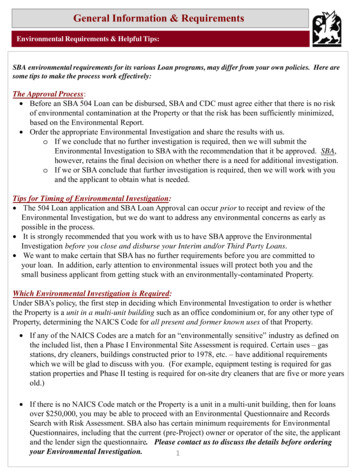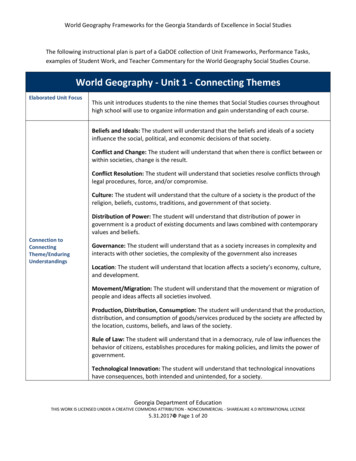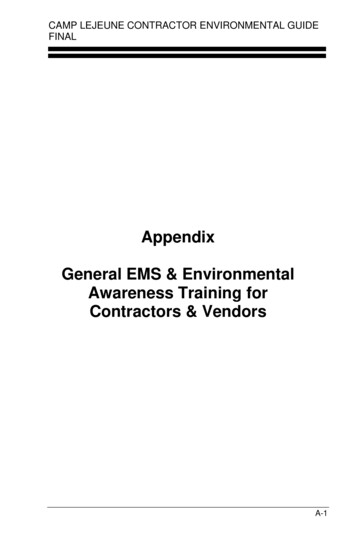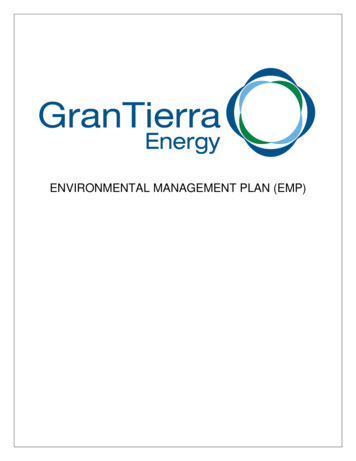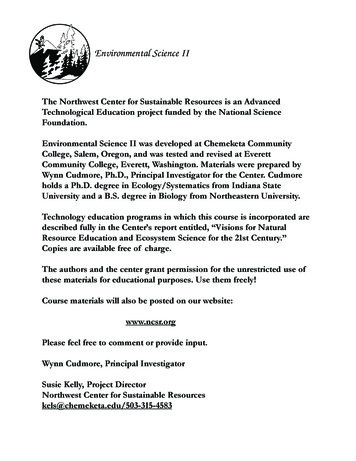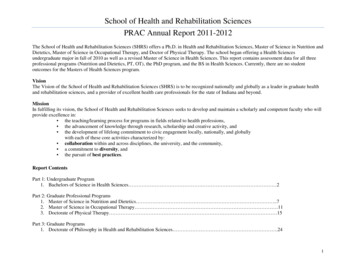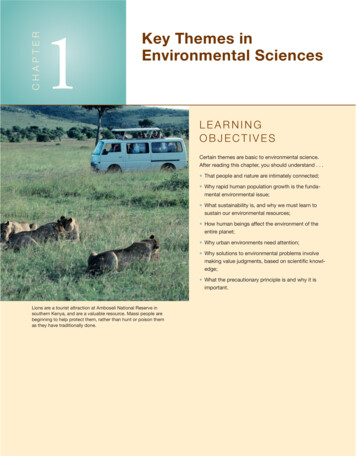
Transcription
CHAPTER1Key Themes inEnvironmental SciencesLEARNINGOBJECTIVESCertain themes are basic to environmental science.After reading this chapter, you should understand . . .s That people and nature are intimately connected;s Why rapid human population growth is the fundamental environmental issue;s What sustainability is, and why we must learn tosustain our environmental resources;s How human beings affect the environment of theentire planet;s Why urban environments need attention;s Why solutions to environmental problems involvemaking value judgments, based on scientific knowledge;s What the precautionary principle is and why it isimportant.Lions are a tourist attraction at Amboseli National Reserve insouthern Kenya, and are a valuable resource. Massi people arebeginning to help protect them, rather than hunt or poison themas they have traditionally done.People around the world are wearing masksto protect themselves against swine flu.(Source: wineflu-photos,0,859331.photogallery [Getty Images Photo / May 2,2009].)
2CHAPTER 1Key Themes in Environmental SciencesCA S E S T U DYAmboseli National Reserve: A Story of ChangeAmboseli National Reserve in southern Kenya is home tothe Maasai people, who are nomadic some of the time andraise cattle. The reserve is also a major tourist destination,where people from around the world can experience Africa and wild animals, such as lions and elephants. Today,environmental change and the future of tourism are beingthreatened in the area. We will consider long-term changeand the more recent management of lions that may resultin their local extinction.Environmental change is often caused by a complexweb of interactions among living things and between living things and their environment. In seeking to determinewhat caused a particular change, the most obvious answermay not be the right answer. Amboseli National Reserveis a case in point. In the short span of a few decades, thisreserve, located at the foot of Mount Kilimanjaro (Figure 1.1), underwent a significant environmental change.L. eBoundarySwamps005510 mi10 15 kmMt. KilimanjaroGranitic rocksFlooded lake sedimentsLake sedimentsKilimanjaro volcanicsDrainageGeneralized geology and landforms of AmboseliNational Reserve, southern Kenya, Africa, and Mount Kilimanjaro. (Source: T. Dunn and L.B. Leopold, Water in EnvironmentalPlanning [San Francisco: Freeman, 1978].)FIGURE 1.1An understanding of physical, biological, and human-usefactors—and how these factors are linked—is needed toexplain what happened.Before the mid-1950s, fever-tree woodlands—mostlyacacia trees and associated grasses and shrubs—dominated the land and provided habitat for mammals that livedin these open woodlands, such as kudu, baboons, vervetmonkeys, leopards, and impalas. Then, beginning in the1950s and accelerating in the 1960s, these woodlandsdisappeared and were replaced by short grass and brush,which provided habitat for typical plains animals, such aszebras and wildebeest. Since the mid-1970s, Amboseli hasremained a grassland with scattered brush and few trees.Loss of the woodland habitat was initially blamed onovergrazing of cattle by the Maasai people (Figure 1.2)and damage to the trees from elephants (Figure 1.3). Environmental scientists eventually rejected these hypotheses as the main causes of the environmental change. Theircareful work showed that changes in rainfall and soils werethe primary culprits, rather than people or elephants.1, 2How did they arrive at this explanation?During recent decades, the mean daily temperaturerose dramatically, and annual rainfall increased but continued to vary from year to year by a factor of four, thoughwith no regular pattern.1, 2 Increased rainfall is generallyassociated with an increased abundance of trees, unlikewhat happened at Amboseli.Why did scientists reject the overgrazing and elephant-damage hypothesis as the sole explanation forchanges in Amboseli? Investigators were surprised to notethat most dead trees were in an area that had been freeof cattle since 1961, which was before the major declinein the woodland environment. Furthermore, some of thewoodlands that suffered the least decline had the highestdensity of people and cattle. These observations suggestedthat overgrazing by cattle was not responsible for loss ofthe trees.Elephant damage was thought to be a major factorbecause elephants had stripped bark from more than83% of the trees in some areas and had pushed over someyounger, smaller trees. However, researchers concludedthat elephants played only a secondary role in changingthe habitat. As the density of fever trees and other woodland plants decreased, the incidence of damage caused byelephants increased. In other words, elephant damage interacted with some other, primary factor in changing thehabitat.1
Case Study: Amboseli National Reserve: A Story of Change3Maasai people grazingcattle in Amboseli National Reserve,Kenya. Grazing was prematurely blamed forloss of fever-tree woodlands.FIGURE 1.2Figure 1.1 shows the boundary of the reserve and themajor geologic units. The park is centered on an ancientlakebed, remnants of which include the seasonally floodedLake Amboseli and some swampland. Mount Kilimanjarois a well-known volcano, composed of alternating layers ofvolcanic rock and ash deposits. Rainfall that reaches theslopes of Mount Kilimanjaro infiltrates the volcanic material (becomes groundwater) and moves slowly down theslopes to saturate the ancient lakebed, eventually emerging at springs in the swampy, seasonally flooded land.The groundwater becomes saline (salty) as it percolatesthrough the lakebed, since the salt stored in the lakebedsediments dissolves easily when the sediments are wet.Because a lot of land has been transformed to agricultural uses, the slopes of Mount Kilimanjaro above Amboseli have less forest cover than they did 25 years ago.The loss of trees exposed dark soils that absorb solar energy, and this could cause local warming and drier conditions. In addition, there had been a significant decrease insnow and ice cover on the high slopes and summit of themountain. Snow and ice reflect sunlight. As snow and icedecrease and dark rock is exposed, more solar energy isabsorbed at the surface, warming it. Therefore, decreasedsnow and ice might cause some local warming.3Research on rainfall, groundwater history, and soilssuggested that the area is very sensitive to changingamounts of rainfall. During dry periods, the salty groundwater sinks lower into the earth, and the soil near thesurface has a relatively low salt content. The fever treesgrow well in the nonsalty soil. During wet periods, thegroundwater rises closer to the surface, bringing with itsalt, which invades the root zones of trees and kills them.The groundwater level rose as much as 3.5 m (11.4 ft) inresponse to unusually wet years in the 1960s. Analysis ofthe soils confirmed that the tree stands that suffered themost damage were those growing in highly saline soils. Asthe trees died, they were replaced by salt-tolerant grassesand low brush.1, 2Evaluation of the historical record—using information from Maasai herders recorded by early Europeanexplorers—and of fluctuating lake levels in other EastAfrican lakes suggested that before 1890 there had beenanother period of above-normal rainfall and loss of woodland environment. Thus, the scientists concluded that cycles of greater and lesser rainfall change hydrology and soilconditions, which in turn change the plant and animal lifeof the area.1 Cycles of wet and dry periods can be expectedto continue, and associated with these will be changes inthe soils, distribution of plants, and abundance and typesof animals present.1Management by the Maasai is proving difficult.Tourists want to see wild lions, but the lions sometimeskill and eat Maasai cattle, so the Maasai are killing theElephant feeding on a yellow-bark acacia tree.Elephant damage to trees is considered a factor in loss of woodlandhabitat in Amboseli National Reserve. However, elephants probablyplay a relatively minor role compared with oscillations in climate andgroundwater conditions.FIGURE 1.3
4CHAPTER 1Key Themes in Environmental SciencesDead lions poisoned by acheap agriculture pesticide.FIGURE 1.4lions. Spearing, a Maasai passage to manhood, remainsthe dominant way to do it: In recent years, of 20 lionskilled, 17 were speared and 3 were poisoned (Figure1.4).4 The poison also kills other animals that scavengecattle, such as hyenas and vultures. Programs to pay theMaasai for cattle lost to lions have problems, so the killing continues. Over 100 lions have been killed in thepast ten years, and in spite of declining lion populations,the killing is still increasing.5 If it doesn’t stop, lions maybecome locally extinct in the reserve, which will dam-age tourism which brings much needed cash to the reserve. As a result, some Massi are now protecting lionsand thus the tourist income (see opening photograph).It may come down to a value judgment: lions on the onehand and cattle and people on the other. The lions mayalso be threatened by a loss of grasslands if the climatecontinues to change and becomes drier. Such a changefavors woodlands, wherein the lion’s natural prey, suchas zebras and wildebeest, are replaced by kudu, impalas,monkeys, and baboons.The Amboseli story illustrates that many environmental factors operate together, and that causes of changecan be subtle and complex. The story also illustrates howenvironmental scientists attempt to work out sequencesof events that follow a particular change. At Amboseli,rainfall cycles change hydrology and soil conditions,which in turn change the vegetation and animals of thearea, and these in turn impact the people living there. Tounderstand what happens in natural ecosystems, we can’tjust look for an answer derived from a single factor. Wehave to look at the entire environment and all of the factors that together influence what happens to life. In thischapter, we discuss some of the fundamental concepts ofstudying the environment in terms of several key themesthat we will revisit at the end of each chapter.has grown, and the population of the world has been increasing by more than 70 million each year. The emergingenergy crisis is producing an economic crisis, as the pricesof everything produced from oil (fertilizer, food, and fuel)rise beyond what some people can afford to pay. Energyand economic problems come at a time of unprecedentedenvironmental concerns, from the local to global level.At the beginning of the modern era—in A.D. 1—thenumber of people in the world was probably about 100million, one-third of the present population of the UnitedStates. In 1960 the world contained 3 billion people. Ourpopulation has more than doubled in the last 40 years, to6.8 billion people today. In the United States, populationincrease is often apparent when we travel. Urban trafficsnarls, long lines to enter national parks, and difficultygetting tickets to popular attractions are all symptoms of agrowing population. If recent human population growthrates continue, our numbers could reach 9.4 billion by2050. The problem is that the Earth has not grown anylarger, and the abundance of its resources has not increased—in many cases, quite the opposite. How, then,can Earth sustain all these people? And what is the maximum number of people that could live on Earth, not justfor a short time but sustained over a long period?1.1 Major Themesof Environmental ScienceThe study of environmental problems and their solutionshas never been more important. Modern society in 2009is hooked on oil. Production has declined, while demand
1.1Estimates of how many people the planet can supportrange from 2.5 billion to 40 billion (a population not possible with today’s technology). Why do the estimates varyso widely? Because the answer depends on what qualityof life people are willing to accept. Beyond a thresholdworld population of about 4–6 billion, the quality of lifedeclines. How many people the Earth can sustain dependson science and values and is also a question about peopleand nature. The more people we pack onto the Earth, theless room and resources there are for wild animals andplants, wilderness, areas for recreation, and other aspectsof nature—and the faster Earth’s resources will be used.The answer also depends on how the people are distributed on the Earth—whether they are concentrated mostlyin cities or spread evenly across the land.Although the environment is complex and environmental issues seem sometimes to cover an unmanageablenumber of topics, the science of the environment comesdown to the central topics just mentioned: the humanpopulation, urbanization, and sustainability within a glob-Major Themes of Environmental Science5al perspective. These issues have to be evaluated in lightof the interrelations between people and nature, and theanswers ultimately depend on both science and nature.This book therefore approaches environmental science through six interrelated themes:s Human population growth (the environmental problem).s Sustainability (the environmental goal).s A global perspective (many environmental problems require a global solution).s An urbanizing world (most of us live and work in urbanareas).s People and nature (we share a common history withnature).s Science and values (science provides solutions; whichones we choose are in part value judgments).You may ask, “If this is all there is to it, what is in therest of this book?” (See A Closer Look 1.1.) The answerA CLOSER LOOK1.1A Little Environmental HistoryA brief historical explanation will help clarify what we seek toaccomplish. Before 1960, few people had ever heard the wordecology, and the word environment meant little as a politicalor social issue. Then came the publication of Rachel Carson’slandmark book, Silent Spring (Boston: Houghton Mifflin,1960, 1962). At about the same time, several major environmental events occurred, such as oil spills along the coasts ofMassachusetts and southern California, and highly publicized threats of extinction of many species, including whales,elephants, and songbirds. The environment became a popularissue.As with any new social or political issue, at first relativelyfew people recognized its importance. Those who did found itnecessary to stress the problems—to emphasize the negative—in order to bring public attention to environmental concerns.Adding to the limitations of the early approach to environmental issues was a lack of scientific knowledge and practicalknow-how. Environmental sciences were in their infancy.Some people even saw science as part of the problem.The early days of modern environmentalism were dominated by confrontations between those labeled “environmentalists” and those labeled “anti-environmentalists.” Stated inthe simplest terms, environmentalists believed that the worldwas in peril. To them, economic and social developmentmeant destruction of the environment and ultimately the endof civilization, the extinction of many species, and perhaps theextinction of human beings. Their solution was a new worldview that depended only secondarily on facts, understanding,and science. In contrast, again in simplest terms, the antienvironmentalists believed that whatever the environmentaleffects, social and economic health and progress were necessaryfor people and civilization to prosper. From their perspective,environmentalists represented a dangerous and extreme viewwith a focus on the environment to the detriment of people, afocus they thought would destroy the very basis of civilizationand lead to the ruin of our modern way of life.Today, the situation has changed. Public-opinion pollsnow show that people around the world rank the environmentamong the most important social and political issues. Thereis no longer a need to prove that environmental problems areserious.We have made significant progress in many areas of environmental science (although our scientific understanding ofthe environment still lags behind our need to know). We havealso begun to create legal frameworks for managing the environment, thus providing a new basis for addressing environmental issues. The time is now ripe to seek truly lasting, morerational solutions to environmental problems.
6CHAPTER 1Key Themes in Environmental Scienceslies with the old saying “The devil is in the details.” Thesolution to specific environmental problems requires specific knowledge. The six themes listed above help us seethe big picture and provide a valuable background. Theopening case study illustrates linkages among the themes,as well as the importance of details.In this chapter we introduce the six themes with briefexamples, showing the linkages among them and touching on the importance of specific knowledge that will bethe concern of the rest of the book. We start with humanpopulation growth.1.2 Human PopulationGrowthOur Rapid Population GrowthThe most dramatic increase in the history of the humanpopulation occurred in the last part of the 20th centuryand continues today into the early 21st century. As mentioned, in merely the past 40 years the human populationof the world more than doubled, from 2.5 billion to about6.8 billion. Figure 1.5 illustrates this population explosion, sometimes referred to as the “population bomb.”The figure shows that the expected decrease in population in the developed regions (for example, the U.S. andWestern Europe) is more than offset by rapid populationgrowth in the developing regions (for example, Africa, India, and South America).Human population growth is, in some importantways, the underlying issue of the environment. Much current environmental damage is directly or indirectly the result of the very large number of people on Earth and ourrate of increase. As you will see in Chapter 4, where weconsider the human population in more detail, for mostof human history the total population was small and the14Billions of people121086Total world populationDevelopingregionsDevelopedregions4201750 1800 1850 1900 1950 2000 2050 2100Population growth in developed and developingnations, 1750 projected to 2100.FIGURE 1.5average long-term rate of increase was low relative to today’s growth rate. 6, 7Although it is customary to think of the population asincreasing continuously without declines or fluctuations,the growth of the human population has not been a steadymarch. For example, great declines occurred during thetime of the Black Death in the 14th century. At that time,entire towns were abandoned, food production declined,and in England one-third of the population died within asingle decade.8Famine and Food CrisisFamine is one of the things that happen when a humanpopulation exceeds its environmental resources. Famineshave occurred in recent decades in Africa. In the mid1970s, following a drought in the Sahel region, 500,000Africans starved to death and several million more werepermanently affected by malnutrition.9 Starvation in African nations gained worldwide attention some ten yearslater, in the 1980s.10, 11Famine in Africa has had multiple interrelated causes.One, as suggested, is drought. Although drought is notnew to Africa, the size of the population affected bydrought is new. In addition, deserts in Africa appear tobe spreading, in part because of changing climate butalso because of human activities. Poor farming practiceshave increased erosion, and deforestation may be helpingto make the environment drier. In addition, the controland destruction of food have sometimes been used as aweapon in political disruptions (Figure 1.6). Today, malnutrition contributes to the death of about 6 million children per year. Low- and middle-income countries sufferthe most from malnutrition, as measured by low weightfor age (underweight, as shown in Figure 1.7).12Famines in Africa illustrate another key theme: people and nature. People affect the environment, and theenvironment affects people. The environment affects agriculture, and agriculture affects the environment. Human population growth in Africa has severely stretchedthe capacity of the land to provide sufficient food and hasthreatened its future productivity.The emerging global food crisis in the first decade ofthe 21st century has not been caused by war or droughtbut by rising food costs. The cost of basic items, such asrice, corn, and wheat, has risen to the point where lowand moderate-income countries are experiencing a serious crisis. In 2007 and 2008, food riots occurred in manylocations, including Mexico, Haiti, Egypt, Yemen, Bangladesh, India, and Sudan (Figure 1.8). The rising costof oil used to produce food (in fertilizer, transportation,working fields, etc.) and the conversion of some cornproduction to biofuels have been blamed. This situationinvolves yet another key theme: science and values. Scien-
1.2Human Population Growth7Science and values. Social conditions affect the environment,and the environment affects social conditions. Political disruption in Somalia (illustrated by a Somalian boy with a gun, left photo) interrupted farming and fooddistribution, leading to starvation. Overpopulation, climate change, and poorfarming methods also lead to starvation, which in turn promotes social disruption. Famine has been common in parts of Africa since the 1980s, as illustratedby gifts of food from aid agencies.FIGURE 1.6tific knowledge has led to increased agricultural production and to a better understanding of population growthand what is required to conserve natural resources. Withthis knowledge, we are forced to confront a choice: Whichis more important, the survival of people alive today orconservation of the environment on which future foodproduction and human life depend?13Answering this question demands value judgments andthe information and knowledge with which to make suchjudgments. For example, we must determine whether wecan continue to increase agricultural production withoutPercent of childrenage 5 underweightLess than 10%10%–19%20%–29%30%–39%40% Not availabledestroying the very environment on which agricultureand, indeed, the persistence of life on Earth depend. Putanother way, a technical, scientific investigation providesa basis for a value judgment.The human population continues to grow, but humans’ effects on the environment are growing even faster.14 People cannot escape the laws of population growth(this is discussed in several chapters). The broad scienceand-values question is: What will we do about the increasein our own species and its impact on our planet and onour future?Underweight children underthe age of 5 by region. Most are in low- andmiddle-income countries. (Source: WorldPopulation Data Sheet [Washington, DC:Population Reference Bureau, 2007. Accessed5/19/08 @www.prb.org].)FIGURE 1.7
8CHAPTER 1Key Themes in Environmental Sciences(a)(b)FIGURE 1.8Food riots over the rising cost of food in 2007. (a) Haiti and (b) Bangladesh.1.3 Sustainabilityand Carrying CapacityThe story of recent famines and food crises brings upone of the central environmental questions: What is themaximum number of people the Earth can sustain? Thatis, what is the sustainable human carrying capacity ofthe Earth? Much of this book will deal with informationthat helps answer this question. However, there is littledoubt that we are using many renewable environmentalresources faster than they can be replenished—in otherwords, we are using them unsustainably. In general, we areusing forests and fish faster than they can regrow, and weare eliminating habitats of endangered species and otherwildlife faster than they can be replenished. We are alsoextracting minerals, petroleum, and groundwater withoutsufficient concern for their limits or the need to recyclethem. As a result, there is a shortage of some resourcesand a probability of more shortages in the future. Clearly,we must learn how to sustain our environmental resourcesso that they continue to provide benefits for people andother living things on our planet.Sustainability:The Environmental ObjectiveThe environmental catchphrase of the 1990s was “savingour planet.” Are all life and the environments on whichlife depends really in danger? Will we leave behind a deadplanet?In the long view of planetary evolution, it is certainthat planet Earth will survive us. Our sun is likely to lastanother several billion years, and if all humans became extinct in the next few years, life would still flourish here onEarth. The changes we have made—in the landscape, theatmosphere, the waters—would last for a few hundred orthousands of years but in a modest length of time wouldbe erased by natural processes. What we are concernedwith, as environmentalists, is the quality of the humanenvironment on Earth, for us today and for our children.Environmentalists agree that sustainability must beachieved, but we are unclear about how to achieve it, inpart because the word is used to mean different things,often leading to confusion that causes people to work atcross-purposes. Sustainability has two formal scientificmeanings with respect to environment: (1) sustainabilityof resources, such as a species of fish from the ocean, a kindof tree from a forest, coal from mines; and (2) sustainability of an ecosystem. Strictly speaking, harvesting a resourceat a certain rate is sustainable if we can continue to harvestthat resource at that same rate for some specified time wellinto the future. An ecosystem is sustainable if it can continue its primary functions for a specified time in the future. (Economists refer to the specified time in the futureas a “planning time horizon.”) Commonly, in discussionsabout environmental problems, the time period is notspecified and is assumed to be very long—mathematicallyan infinite planning time, but in reality as long as it couldpossibly matter to us. For conservation of the environment and its resources to be based on quantitative science,both a rate of removal and a planning time horizon mustbe specified. However, ecosystems and species are alwaysundergoing change, and a completely operational definition of sustainability will have to include such variationover time.Economists, political scientists, and others also usethe term sustainability in reference to types of development that are economically viable, do not harm the environment, and are socially just (fair to all people). Weshould also point out that the term sustainable growth is anoxymoron (i.e., a contradictory term) because any steady
1.3growth (fixed-percentage growth per year) produces largenumbers in modest periods of time (see ExponentialGrowth in Chapter 3).One of the environmental paradigms of the 21st century will be sustainability, but how will it be attained?Economists have begun to consider what is known as thesustainable global economy: the careful management andwise use of the planet and its resources, analogous to themanagement of money and goods. Those focusing on asustainable global economy generally agree that underpresent conditions the global economy is not sustainable.Increasing numbers of people have resulted in so muchpollution of the land, air, and water that the ecosystemsthat people depend on are in danger of collapse. What,then, are the attributes of a sustainable economy in theinformation age?15s Populations of humans and other organisms living inharmony with the natural support systems, such as air,water, and land (including ecosystems).s An energy policy that does not pollute the atmosphere,cause climate change (such as global warming), or poseunacceptable risk (a political or social decision).s A plan for renewable resources—such as water, forests,grasslands, agricultural lands, and fisheries—that willnot deplete the resources or damage ecosystems.s A plan for nonrenewable resources that does not damage the environment, either locally or globally, and ensures that a share of our nonrenewable resources will beleft to future generations.s A social, legal, and political system that is dedicated tosustainability, with a democratic mandate to producesuch an economy.Recognizing that population is the environmentalproblem, we should keep in mind that a sustainable global economy will not be constructed around a completelystable global population. Rather, such an economy willtake into account that the size of the human populationwill fluctuate within some stable range necessary to maintain healthy relationships with other components of theenvironment. To achieve a sustainable global economy, weneed to do the following:15s Develop an effective population-control strategy. Thiswill, at least, require more education of people, sinceliteracy and population growth are inversely related.s Completely restructure our energy programs. A sustainable global economy is probably impossible if it is basedon the use of fossil fuels. New energy plans will be basedon an integrated energy policy, with more emphasis onrenewable energy sources (such as solar and wind) andon energy conservation.Sustainability and Carrying Capacity9s Institute economic planning, including a tax structurethat will encourage population control and wise use ofresources. Financial aid for developing countries is absolutely necessary to narrow the gap between rich andpoor nations.s Implement social, legal, political, and educationalchanges that help to maintain a quality local, regional,and global environment. This must be a serious commitment that all the people of the world will cooperatewith.Moving toward Sustainability:Some CriteriaStating that we wish to develop a sustainable future acknowledges that our present practices are not sustainable.Indeed, continuing on our present paths of overpopulation, resource consumption, and pollution will not lead tosustainability. We will need to develop new concepts thatwill mold
of Environmental Science The study of environmental problems and their solutions has never been more important. Modern society in 2009 is hooked on oil. Production has declined, while demand has grown, and the population of the world has been in

